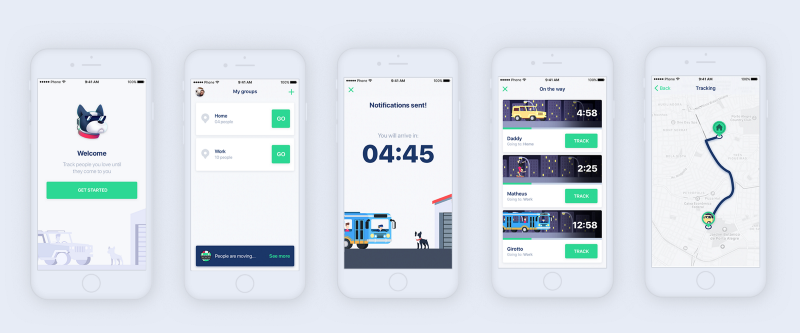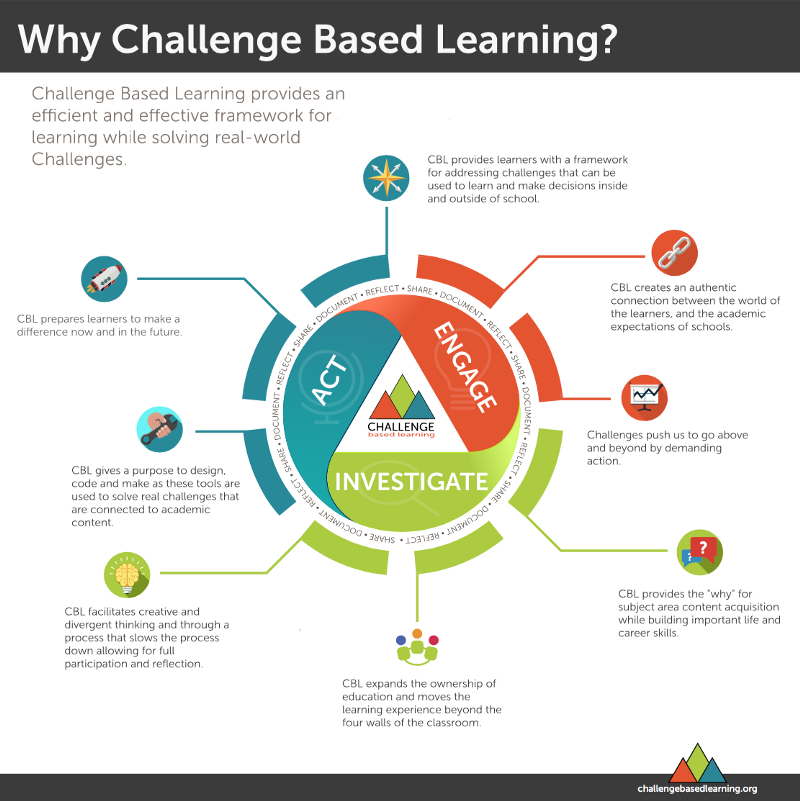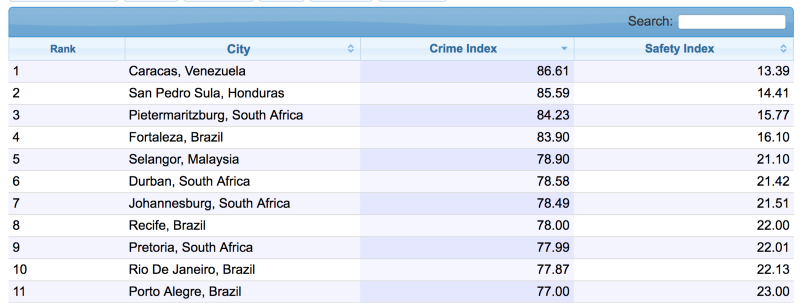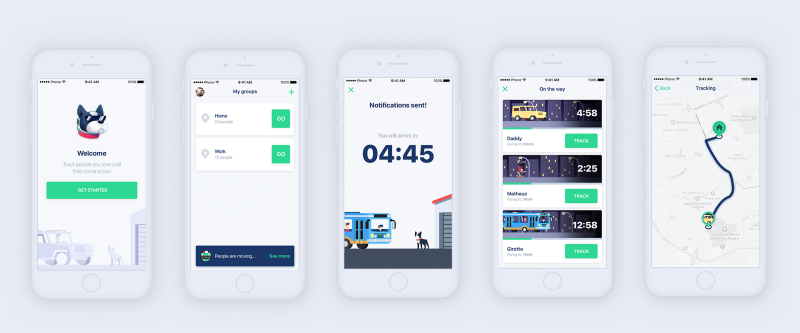by Jonata Corrêa
How we used Apple’s learning framework to create our first app

After one month of work, my team and I finished the first version of Echo, our tracker iOS application. We built it as a result of a challenge created by the Challenge Based Learning (CBL) method and it was a great experience.
Our app allow users to share their location with people they love and let this people track their location in real time when they are going home. This way, everyone can act as guardians by always knowing what is happening and taking actions if necessary. It’s a simple idea built to help people in our community.
I want to share what is CBL and how it helped us to ideate, prototype and launch or solution, so others can use this technique to create awesome projects too.
What’s CBL?
“Challenge Based Learning (CBL) provides an efficient and effective framework for learning while solving real-world Challenges. The framework is informed by innovative practices in education, media, technology, entertainment, recreation, the workplace and society.” — Digital Promise
Today’s students must solve problems in content-centric classrooms, but these problems usually lack real world context. It’s hard to a student feel engaged when they don’t see the connection between what they are learning and the real world. There is where the CBL comes in.
CBL is a learning framework to help students learn by resolving real world problems and generating solutions to help their community. What you learn building something is the type of knowledge you never forget, CBL allows you to learn while having fun in the process. And most important, it engages students.
The framework emerged from an educational projected created by Apple and has been tested all over the world. It provides a better way to learn and solve problems at the same time.
It is flexible, customizable and scalable. You can use it to learn almost anything and improves the chances of your projects actually fit the real needs of real people.
How it made the process easier?
For us, CBL was the solid foundation where our team could have some idea, evolve it and throw it away if necessary. It is, in our opinion, the best way to learn, and feel engaged and connected to a topic you are building on.
Learning and creating something can be very hard. Challenge Based Learning makes it easier by giving the tools necessary to guide you through the steps of going a from a raw idea to a final product.
How it works?
The framework has 3 phases: Engage, Investigate and Act. Each phase creates the foundation for the next one. By the end of the process you will have gone from a Big and ideological idea to a final and useful solution.

Engage:
The first phase is by far the most important one. This is where you brainstorm ideas and move from an abstract concept called big idea to a actionable challenge. This phase consists of 3 steps: Big idea, essential question and challenge
You must define which Big Idea you will work with. It has to be a broad concept that can be explored in multiple ways. Every topic that is meaningful to you and the larger community can be a Big Idea. Some examples are: Relationships, Health, Security, Programming, Learning and Politics. It’s important to choose a topic that you and your group care about, that you can relate to and feel that you can do something about. The more you like your big idea, the easier will be to learn, have fun and create a useful and meaningful solution.
We chose home safety. Since our home town is right now the 11th most dangerous city in the world, it was a very resonating topic to us.

After choosing your big idea, break it down to an actionable challenge by using the essential question process. The big idea must generate a wide variation of questions about the problems and needs of the area.
You and your team must start asking questions about the problem and take notes. From these questions you are going to select one question that has a very strong meaning to the group. This will be your essential question.
The essential question must be the link between your lives and the big idea. The question needs to be provocative and must encourage research to answer it.
Some examples of essential question and their big ideas are:
- Security: How people feel arriving or leaving their home? (used at Echo)
- Health: What is a healthy lifestyle?
- Economy: How does graduating from high school or college affect the economy?
- Climate change: What is the impact of my use of fossil fuels on my planet?
The next step is to turn the essential question into a call to action by challenging the group to create a local solution to a global problem . The result is that you will have the challenge to work with. You must know that what you learn will be the consequence of the challenge you will choose, and not the opposite. It’s important to pay attention to the process that will lead you to choose your challenge.
It’s important for the challenge to have 2 facets: Be a close to home and yet have a greater meaning. For instance, our challenge was: Create a safer home environment for everyone. As you can see this challenge is very close to us and also has a global appealing. This way you have personal meaning and a sense of bigger purpose.
“If the challenge is too broad or vague, students will flounder. If it is too narrow, they will not be able to fully experience the self direction that is required to develop the skills that Challenge Based Learning cultivates.” — Digital Promise
Some examples of challenges are:
- Climate change: Reduce your’s family fossils consumption.
- Health: Help your friends to develop healthier habits.
- Conflict: Improve tolerance at your school.
The Engage phase concludes with the creation of a compelling and actionable Challenge statement.
Investigate:
“The learners plan and participate in a journey that builds the foundation for solutions and addresses academic requirement.” — Digital Promise
During the Investigate phase we ask questions, do research and document everything. This helps us to better understand the problem and clarify our ideas about the challenge we are trying to solve.
This phase breaks down into:
- developing Guiding Questions
- identifying Activities and Resources to answer these questions
- and Research Analysis
If the challenge connects to a specific area (in our case was create an iOS application), then this phase is where you must align these interests and try to find a way to create a solution using the applicable knowledge of the area you are working with.
The Guiding questions:
Once your group has determined the challenge, you must generate questions to include everything the group needs to learn to develop a solution for the challenge. Every need and every doubt the group has must be written down as a guiding question. The idea is to find what you must know to solve the problem defined by the challenge. Some examples of guiding questions about water-related challenge are:
- How do we use water?
- How much water do we use?
- How is water wasted?
- How much water is wasted?
The bigger your list of questions, the better. Never assume something for granted. Obvious and basic questions like “Where does water come from?” are usually the ones that lead to the best ideas.
Brainstorm everything you know about your challenge and what you still need to discover. This is a good way to kick-start your guiding questions.
Activities & Resources:
You must study your guiding questions and decide which resource to use or activity to do to answer the question. A good way to find the guiding activities is to create three-column matrix with the guiding questions in the first column and the related activities/resources in the second column. After completing the activities, place the results in the third column.
Examples of Guiding Resources include: online content and courses, databases, textbooks, and social networks.
Examples of Guiding Activities include: simulations, experiments, projects, problem sets, research, and games.
Analysis:
Once you have your results it’s time to analyze the accumulated data and identify themes. When we were building Echo this phase made us realize something interesting: People were afraid of being assaulted when they are entering and leaving their homes. So that was the point we needed to solve, we have to create a solution to make it safer for people to enter and leave their home by letting their friends know where they are going and when they are arriving.
Act:
“In the Act Phase evidence-based solutions are developed and implemented with an authentic audience and the results evaluated. The Learners combine a desire to make a difference with a demonstration of content mastery.” — Digital Promise
Once you complete the investigation phase, you will have a solid foundation to begin developing your solution concepts. From now on you must create the best solution you can to help solve the challenge you choose. This phase has 3 parts. Solution, implementation and evaluation.
The solution part is where you analyze the data generated by the investigation phase to find a single solution to sketch and prototype. Don’t be afraid to consider many solutions and throw away many of them. It is important is to find something that matches the needs of the challenge and the interest of the group.
After identifying your solution, you must implement it. This phase changes from project to project but all you have to do is bring the solution you defined to life.
Now you have you working solution and the next step is to evaluate the outcome by defining some key points and look back to the process to reflect on what worked and what didn’t.
Keep learning
Here I gave you the summary of CBL. But if you want to dive deeper (which I recommend), here are some links I used as reference:
Thank’s for reading
Thanks for your time! Feel free to contact me or any of anyone of my team mates.
- Developers: Jonata Correa, Guilherme Girotto, Victor Melo
- Designer: Bruno Quadros, Matheus Viana
- Link to download Echo: https://goo.gl/CUK8oz
